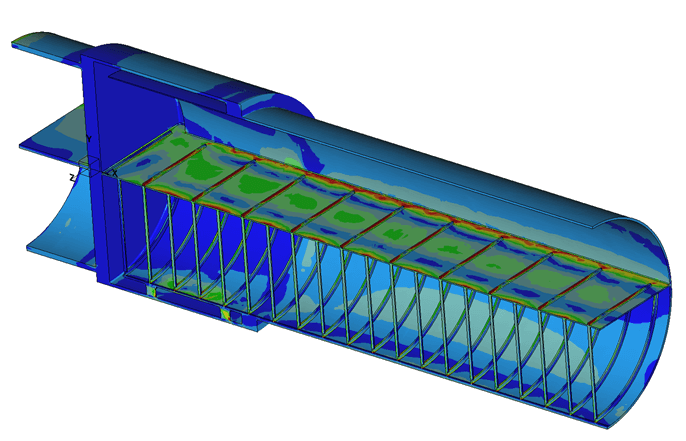A finite element method (FEM) analysis was conducted on a molten salt and oil heat exchanger utilized at a solar plant facility. This heat exchanger, which is part of a series of three identical units connected in sequence, operates under relatively high pressures and temperatures. It experiences cycling variations in pressure and temperature between day and night operations.
Therefore, a comprehensive static design assessment, fatigue evaluation, and transient analysis were essential for ensuring the heat exchanger’s performance throughout its operational lifetime. The assessment adhered to ASME Section VIII Division 2 standards, using material allowables from ASME Section VIII Division 1.
Assessment
The assessment involved a detailed examination of the critical areas of the heat exchanger. The heat exchanger was divided into multiple component models, each evaluated individually for primary stress, shakedown, and fatigue.
Primary Assessment: This evaluation aimed to protect the heat exchanger from plastic collapse or rupture within the shell body during operation. High-stress areas identified in the FEM model were linearized to assess membrane and bending stress components. These stress components were then compared against ASME Section VIII Division 1 material allowables.
Fatigue Assessment: This aspect of the evaluation proved more complex. Key parameters included the type of weld, the location of high stress (whether at the weld toe or root), inspection quality, and the operating stress range. Critical welds were examined further by analyzing stress tensor components to determine the operating stress range. By evaluating stress tensor components between different operating states, the cyclic behavior of the stress range was better understood, enhancing the accuracy of the fatigue assessment.
Transient Analysis: The transient analysis addressed daily start-up scenarios at the inlet and outlet nozzles, as well as the tube bundle. This procedure, which occurs daily, involves significant temperature gradients at the nozzles and tube bundle. The analysis accounted for the cooling effect of the molten salt, critical temperature heating paths, and varying heat transfer coefficients with temperature.

Results
The stress analysis led to several design recommendations, including structural modifications, changes in weld type and inspection quality, and procedural adjustments during the heat exchanger’s start-up. The fatigue assessment highlighted welds as the most critical aspect of the design. By carefully selecting inspection quality and weld types, fatigue-related issues can be significantly mitigated.






